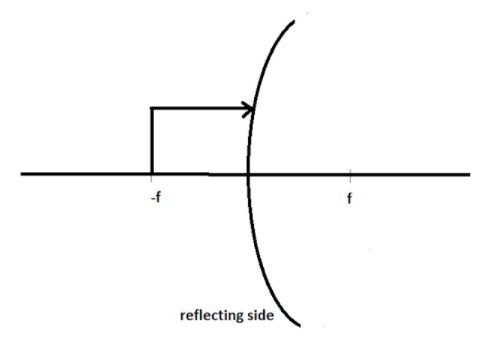
A convex mirror has a focal length $f$. A real object is placed at a distance $f$ in front of it from the pole produces an image at:
A) $\infty $
B) $f$
C) $\dfrac{f}{2}$
D) $2f$
Answer
217.2k+ views
Hint: To solve this question we have to use mirror formulae. Also, for a convex mirror, the focal length is on the painted side. So it is considered positive while the object distance is considered negative.
Formulae used:
$\dfrac{1}{f} = \dfrac{1}{v} + \dfrac{1}{u}$
Here $f$ is the focal length for the mirror, $v$ is the distance of image from the pole and $u$ is the distance of the object from the pole.
Complete step by step answer:
In the question, a convex mirror is given. It is said that it has a focal length of $f$ and the object is kept at $f$ distance in front of the image.
Let’s see the diagram of a convex mirror.

We know that all the distance in the direction of the light source is considered positive whereas the distance in the opposite directions is considered negative. So for a convex mirror, the focal length is considered positive as it is on the non-reflecting side of the mirror i.e. in the direction of the light source. As the object is present in the opposite direction of the light source, its distance is considered negative. Here,
Focal length =$f$ and
Object distance = $ - f$
Applying the mirrors formulae,
$ \Rightarrow \dfrac{1}{f} = \dfrac{1}{v} + \dfrac{1}{u}$
Here $f$ is the focal length for the mirror, $v$ is the distance of the image from the pole and $u$ is the distance of the object from the pole.
Substituting the values of focal length and object distance, we get
$ \Rightarrow \dfrac{1}{f} = \dfrac{1}{v} + \dfrac{1}{{ - f}}$
$ \Rightarrow \dfrac{1}{v} = \dfrac{1}{f} + \dfrac{1}{f}$
$ \Rightarrow \dfrac{1}{v} = \dfrac{2}{f}$
$ \therefore v = \dfrac{f}{2}$
So the answer will be $\dfrac{f}{2}$ in the direction of the light source i.e. on the non-reflecting side of the mirror.
Hence option (C) is the answer.
Note: Always use the mirror formulae after proper use of signs. The positive or negative signs should be given according to their direction from the light source. The one which is in the backward direction of the light source should be given negative signs and the one which is in the direction of the light source is considered positive.
Formulae used:
$\dfrac{1}{f} = \dfrac{1}{v} + \dfrac{1}{u}$
Here $f$ is the focal length for the mirror, $v$ is the distance of image from the pole and $u$ is the distance of the object from the pole.
Complete step by step answer:
In the question, a convex mirror is given. It is said that it has a focal length of $f$ and the object is kept at $f$ distance in front of the image.
Let’s see the diagram of a convex mirror.

We know that all the distance in the direction of the light source is considered positive whereas the distance in the opposite directions is considered negative. So for a convex mirror, the focal length is considered positive as it is on the non-reflecting side of the mirror i.e. in the direction of the light source. As the object is present in the opposite direction of the light source, its distance is considered negative. Here,
Focal length =$f$ and
Object distance = $ - f$
Applying the mirrors formulae,
$ \Rightarrow \dfrac{1}{f} = \dfrac{1}{v} + \dfrac{1}{u}$
Here $f$ is the focal length for the mirror, $v$ is the distance of the image from the pole and $u$ is the distance of the object from the pole.
Substituting the values of focal length and object distance, we get
$ \Rightarrow \dfrac{1}{f} = \dfrac{1}{v} + \dfrac{1}{{ - f}}$
$ \Rightarrow \dfrac{1}{v} = \dfrac{1}{f} + \dfrac{1}{f}$
$ \Rightarrow \dfrac{1}{v} = \dfrac{2}{f}$
$ \therefore v = \dfrac{f}{2}$
So the answer will be $\dfrac{f}{2}$ in the direction of the light source i.e. on the non-reflecting side of the mirror.
Hence option (C) is the answer.
Note: Always use the mirror formulae after proper use of signs. The positive or negative signs should be given according to their direction from the light source. The one which is in the backward direction of the light source should be given negative signs and the one which is in the direction of the light source is considered positive.
Recently Updated Pages
Addition of Three Vectors: Methods & Examples

Addition of Vectors: Simple Guide for Students

Algebra Made Easy: Step-by-Step Guide for Students

Relations and Functions: Complete Guide for Students

Analytical Method of Vector Addition Explained Simply

Arithmetic, Geometric & Harmonic Progressions Explained

Trending doubts
JEE Main 2026: Application Form Open, Exam Dates, Syllabus, Eligibility & Question Papers

Derivation of Equation of Trajectory Explained for Students

Hybridisation in Chemistry – Concept, Types & Applications

Understanding the Angle of Deviation in a Prism

Understanding Collisions: Types and Examples for Students

How to Convert a Galvanometer into an Ammeter or Voltmeter

Other Pages
JEE Advanced Marks vs Ranks 2025: Understanding Category-wise Qualifying Marks and Previous Year Cut-offs

Understanding Atomic Structure for Beginners

Ideal and Non-Ideal Solutions Explained for Class 12 Chemistry

Degree of Dissociation: Meaning, Formula, Calculation & Uses

Understanding Electromagnetic Waves and Their Importance

Understanding the Electric Field of a Uniformly Charged Ring




